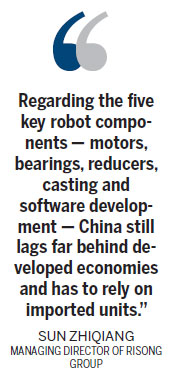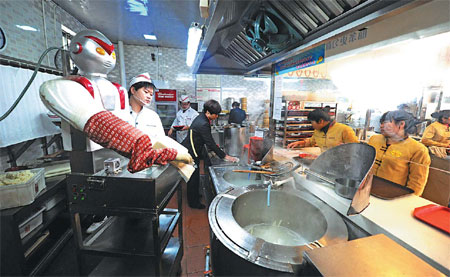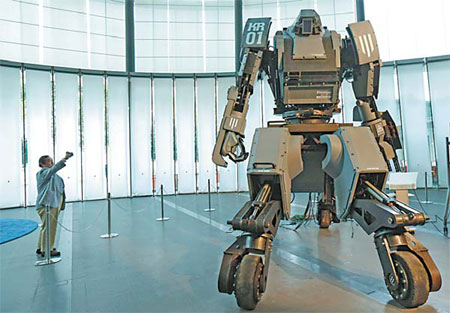Chinese robot wars set to erupt
Updated: 2012-12-06 08:10
By He Wei (China Daily)
|
|||||||||
|
A robot makes noodles in a restaurant in Changsha, the capital of Hunan province. Chinese businesses are predicting a boom in the use of robots in the country. Yang Huafeng / China News Service |
|
A giant "Kuratas" robot on display at an exhibition in Tokyo in November. The 4-meter-high, limited edition, made-to-order robot is controlled by a pilot in its cockpit, or via a smartphone. Kim Kyung-Hoon / Reuters |

Rising labor costs and an upcoming demographic crisis are driving up demand for 'automated workers' in China, as companies strive to retain their competitive edge. He Wei reports from Shanghai.
Sun Zhiqiang says the timing of China's robot spree is perfect for his business. As managing director of Risong Group, an automation company in Guangzhou, Guangdong province that provides robotic systems, Sun's company has cashed in on the robotics boom during the past two years. Although he declined to provide details, Sun revealed that the company is making almost 20 times the revenue it did when the business started 15 years ago.
Established by Sun, an engineer by training, Risong was a pioneer in the introduction of robotics systems in China. However, in the early days the company hemorrhaged money, because the concept of robot workers failed to catch on.
"Back then, no one was really into robots," Sun recalled. "I was given the cold shoulder every time I tried to promote the products. The response was always: 'We have inexhaustible human labor.' So why bother to use robots?"
But a change in demographics has helped to open the window of opportunity. China's working-age population is set to shrink and labor costs are likely to spiral upward as a result. That has given a fresh impetus to the development of robots.
A 2011 census conducted by the National Bureau of Statistics projected that the working-age population will begin to decline in 2013, and the decrease will gather pace after 2020, signaling the end of what has been called "the demographic bonus".
Recent research conducted by the consultancy Ernst & Young LLP suggests that the average annual labor cost per worker rose to more than 40,000 yuan ($6,400) in 2011, from less than 25,000 yuan five years ago.
Given the context, it's easy to calculate the tradeoffs of getting a robot. "In fact, industrial robots are already cheaper than workers in China's eastern regions," said Wang Tianmiao, who heads the expert panel of robot technology under the State High-Tech Development Plan.
Wang said a typical industrial robot costs around 300,000 yuan and has annual maintenance costs of 20,000 yuan. The total layout of 500,000 yuan over 10 years is considerably less than that for a 6,000-yuan-a-month technician, and robots can work three times more efficiently.
An explosive market
In general, robots fall into two categories, industrial and service, according to a definition provided by the International Federation of Robotics (IFR), an industry alliance in Frankfurt, Germany.
Industrial robots are used in industrial automation applications, while service robots are usually found in the fields of medicine, inspection and maintenance systems, but they also have personal and domestic uses.
However, the revenue from service robots is meager compared with that of industrial robots. In 2011, the industrial robot market was worth $8.5 billion, while service robots accounted for just $636 million.
The automation boom has flourished since 2010, when Chinese companies rushed to embrace industrial robots for manufacturing and equipment operation, Sun recalled. The new market buoyancy saw new orders piling up and provided a decent return for Risong. As evidence of the trend, in 2011 Foxconn Technology Group, whose factories on the Chinese mainland assemble iPads for Apple Inc, vowed to install as many as 1 million robots over the next three years.
Robots are efficient: They can work 24 hours a day, offer more output in repetitive work, are much more accurate and keep manufacturers away from reliance on human labor, said Zhu Shiqiang, a professor in the Department of Mechanical Engineering at Zhejiang University in Hangzhou.
Globally, 2011 saw robot sales soar 38 percent year-on-year to 166,028 units, by far the highest level recorded for a single year, according to the IFR.
China accounted for a large part of that robust growth, with 22,600 units sold, a rise of 51 percent compared with 2010. The number of industrial robots sold in China annually quadrupled between 2006 and 2011.
China now ranks as the globe's sixth-largest market in terms of robot installation, and the IFR predicts that the country will overtake Japan as the top consumer of industrial robots by 2014, with demand reaching 32,000 units.
Robotic zones
The Chinese government supports the development of robots. The 12th Five-Year Plan (2011-15) outlined a plan for overall revenue in the intelligent equipment sector to surpass 1 trillion yuan by 2015, a compound growth rate of 25 percent, said Wang Weiming, deputy director of the equipment industry department of the Ministry of Industry and Information Technology.
The ambitious target also includes 30 percent of intelligent equipment with homegrown technologies. It further set out to localize production of robotics and relevant electrical machinery by the end of the plan, Wang said.
Currently, there are at least six major robotics zones nationwide, according to Zhao Yong, chief operating officer of robot-china, an online information provider for the domestic industry.
The zones are largely centered in and around China's key economic bases such as Shanghai, Beijing, Guangzhou and Chengdu.
The municipal government of Shanghai has listed robots as one of its major industries in the coming years, and it hopes the industry will generate as much as 20 billion yuan by 2015, according to Dai Haibo, director of the Shanghai Commission of Economy and Information Technology.
So far, the city has garnered industry heavyweights such as Germany's Kuka AG, Switzerland's ABB Group, Japan's Fanuc Corp and China's top indigenous robot manufacturer, Siasun Robot and Automation Co.
The local government is also encouraging such businesses to settle in the Shanghai Industrial Park of Robotics, the largest robotics zone in the country, said Wang Huai, head of Baoshan Gucun township government in Shanghai.
The 3.09-square-kilometer zone aims to serve leading robot makers by producing state-of-the-art products and contributing to the internationalization of Chinese robotics standards, he said.
However, the government has yet to subsidize its own enterprises, Zhao noted. "It will probably take another five years to get those details right on track."
Nevertheless, the lack of preferential policies towards local businesses may spell opportunities for their foreign counterparts, and the industry giants are looking to capitalize on the nation's automation boom.
In October, Kuka laid the cornerstone of a new plant in Shanghai, which it hopes will meet the soaring demand for automation in the region.
As the only factory outside of Kuka's home country, the facility will reach an annual capacity of 3,000 units in its first year and is expected to grow to 5,000 units by the end of 2015, according to CEO Till Reuter.
Kuka's robot series is set to be applied widely in the automotive industry, he said. That accords with statistics from the IFR showing that at 36 percent, the auto sector has the largest share of industrial robot usage worldwide.
Meanwhile, ABB has just set up the first research and development platform for its Train Control and Monitoring System in China, a technique that is critical to traction systems and a core technology in urban mass-transit vehicles.
The company established its first global quality center in Shanghai earlier this year, following the relocation of its robotics research and development headquarters to the city from Detroit in 2006.
Gu Chunyuan, head of ABB's regional Discrete Automation and Motion Control Division in North Asia and China, predicted that more companies will invest in robotics as they look to cut operating costs and improve product quality and consistency. That would see the market to grow into one of the most developed in the world.
Manufacturers also want to employ robots in other sectors. Switzerland's Staubli Holding AG is planning to double its sales this year, compared with 2011, with hundreds of robots in the Chinese market.
So far this year, the company has invested 200 million yuan in expanding its manufacturing facility in Hangzhou, Zhejiang province, for its three divisions: textile machinery, connectors and robotics. Looking forward, it also plans to build an industrial robot assembly production line.
Employment fears
However, there are fears that the robot boom could result in a rise in unemployment. Li Gang, vice-president of ABB's robotics sector in China, said robots are complimentary to the human workforce, because they are mostly deployed in regions with where labor is in short supply. In addition, some of the robots are specifically designed to work in dangerous or special environments where conditions could pose a risk to human health.
Despite the thriving prospects, China's robot manufacturing capacity is still below those in competitor countries, according to the experts.
The country still relies heavily on imported robots. In 2011, they increased by 62 percent year-on-year to 38,000, with the top foreign companies accounting for 80 percent of the local market, according to the IFR.
Moreover, China still ranks low in the global robotic hierarchy. There are 21 robots for every 10,000 workers, according to IFR data. The figure is less than half the global average of 55, and far lags behind the 135 in the United States, Germany's 251 and Japan's 339.
In terms of patents, Japan holds all the top spots for robot control, sensor and actuator technologies, said Zhao Jie, executive vice-director of the State Key Lab of Robotics and System at Harbin Institute of Technology. China, in contrast, has barely made any progress.
Despite more than a decade of research, domestic companies are still failing to reach international standards in critical robot techniques, according to Sun.
"Regarding the five key robot components - motors, bearings, reducers, casting and software development - China still lags far behind developed economies and has to rely on imported units," he said.
For instance, the repeat accuracy of a foreign manipulator, the measurement of the variation in the actual position of a robot manipulator from one cycle to the next, can be as little as 0.03 millimeter, he noted. The number for a similar Chinese robot, in contrast, is 1 mm.
The industry needs to make a concerted effort to integrate and make better use of resources in developing key technologies, said Zhao Jie.
At least 30 universities and research institutes in China have embarked on robot technologies and about 60 companies are manufacturing robots.
Zhao urged the central government to establish a top-down strategy by appointing certain academies and enterprises to handle a designated task and make breakthroughs in specific areas. In that way, people would be more likely to share resources.
"If each company has its own agenda, they tend to safeguard their own resources instead of sharing them," said Zhao.
Zhu from Zhejiang University urged the government to establish an independent and unified Robotics Academy at the national level, because at present robotics alliances are spread across various machinery federations, leading to inefficiency.
However, until those and other problems are addressed, China will continue to be a bit-part player in robot manufacturing. After years of operations, foreign operators have achieved successful economies of scale, which greatly trim production costs. That has made it difficult for domestic players to gain a competitive edge in pricing, according to Zhou.
Sun from Risong admitted that he would rather pay 280,000 yuan for a robot from Kuka or ABB than spend perhaps 250,000 on one made by a Chinese company. "The price difference is not as significant as the gap in technologies. If you pay 30,000 yuan extra, you get to acquire technologies that are 30 years ahead. It's an easy choice to make."
Contact the reporter at hewei@chinadaily.com.cn
(China Daily 12/06/2012 page6)

 Relief reaches isolated village
Relief reaches isolated village
 Rainfall poses new threats to quake-hit region
Rainfall poses new threats to quake-hit region
 Funerals begin for Boston bombing victims
Funerals begin for Boston bombing victims
 Quake takeaway from China's Air Force
Quake takeaway from China's Air Force
 Obama celebrates young inventors at science fair
Obama celebrates young inventors at science fair
 Earth Day marked around the world
Earth Day marked around the world
 Volunteer team helping students find sense of normalcy
Volunteer team helping students find sense of normalcy
 Ethnic groups quick to join rescue efforts
Ethnic groups quick to join rescue efforts
Most Viewed
Editor's Picks

|

|

|

|

|

|
Today's Top News
Health new priority for quake zone
Xi meets US top military officer
Japan's boats driven out of Diaoyu
China mulls online shopping legislation
Bird flu death toll rises to 22
Putin appoints new ambassador to China
Japanese ships blocked from Diaoyu Islands
Inspired by Guan, more Chinese pick up golf
US Weekly

|

|









